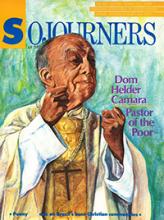In everyone's life there are important turnings in the road that offer a new perspective. My first encounter with liberation theologian Leonardo Boff in his homeland, Brazil, was one such experience.
I had met Leonardo in Venezuela during a religious conference, and his description of Brazil's first national meeting of Christian base communities intrigued me. The meeting was to be held in the coastal city of Vitoria, north of Rio de Janeiro, and Leonardo said I would be welcome.
Read the Full Article

Already a subscriber? Login
